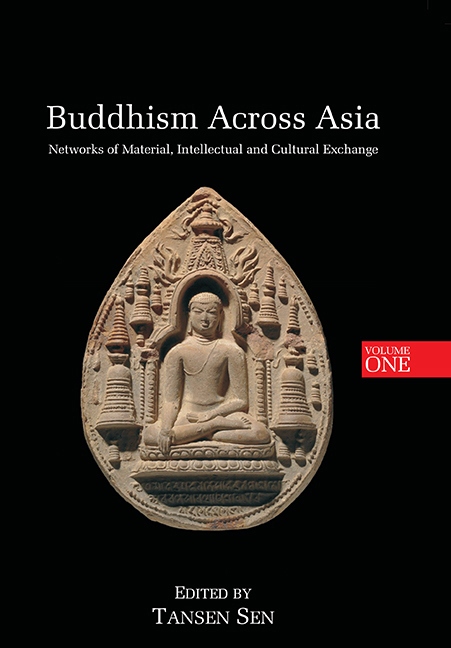Book contents
- Frontmatter
- Dedication
- Contents
- Introduction: Buddhism in Asian History
- Part I Tran smissions of Buddhism Before the Seventh Century
- 1 Networks for Long-distance Transmission of Buddhism in South Asian Transit Zones
- 2 Truth and Scripture in Early Buddhism: Categorial Reduction as Exegetical Method in Ancient Gandhāra and Beyond
- 3 Now You Hear it, Now You Don't: The Phrase “Thus Have I Heard” in Early Chinese Buddhist Translations
- 4 The First Āgama Transmission to China
- 5 What is a “Hīnayāna Zealot” Doing in Fifth-Century China?
- 6 Meditation Traditions in Fifth-Century Northern China: With a Special Note on a Forgotten “Kaśmīri” Meditation Tradition Brought to China by Buddhabhadra (359-429)
- 7 Transmission of the Dharma and Reception of the Text: Oral and Aural Features in the Fifth Chapter of the Book of Zambasta
- Part II Buddhism Across Asia between the Seventh and Fifteenth Centuries
- Part III Buddhist Connections after the Fifteenth Century
- List of Contributors
- Index
- Miscellaneous Endmatter
7 - Transmission of the Dharma and Reception of the Text: Oral and Aural Features in the Fifth Chapter of the Book of Zambasta
from Part I - Tran smissions of Buddhism Before the Seventh Century
Published online by Cambridge University Press: 21 October 2015
- Frontmatter
- Dedication
- Contents
- Introduction: Buddhism in Asian History
- Part I Tran smissions of Buddhism Before the Seventh Century
- 1 Networks for Long-distance Transmission of Buddhism in South Asian Transit Zones
- 2 Truth and Scripture in Early Buddhism: Categorial Reduction as Exegetical Method in Ancient Gandhāra and Beyond
- 3 Now You Hear it, Now You Don't: The Phrase “Thus Have I Heard” in Early Chinese Buddhist Translations
- 4 The First Āgama Transmission to China
- 5 What is a “Hīnayāna Zealot” Doing in Fifth-Century China?
- 6 Meditation Traditions in Fifth-Century Northern China: With a Special Note on a Forgotten “Kaśmīri” Meditation Tradition Brought to China by Buddhabhadra (359-429)
- 7 Transmission of the Dharma and Reception of the Text: Oral and Aural Features in the Fifth Chapter of the Book of Zambasta
- Part II Buddhism Across Asia between the Seventh and Fifteenth Centuries
- Part III Buddhist Connections after the Fifteenth Century
- List of Contributors
- Index
- Miscellaneous Endmatter
Summary
Introduction
This article examines the story of the Buddha's first return to his home city Kapilavastu after his awakening, as found in the fifth chapter of the Buddhist work known as the Book of Zambasta. This is possibly the oldest extant Buddhist text in Khotanese, an Eastern Middle Iranian language once spoken and written in Central Asia, in part of what is now the north-western Chinese region of Xinjiang.
My purpose here is to investigate the fifth chapter in the context of the reception of the Mahāyāna in Khotan. In particular, I explore how an appreciation of the mode of transmission of the text, through the analysis of its structure and contents and in comparison with a number of possible sources and parallels, can contribute to the reconstruction of the first documentable stages in the spread of the Buddhadharma to Khotan.
Chapter five is found as such in the only virtually complete manuscript of the Book of Zambasta, stemming from the eighth century. It was not included in ms. T III S 16, the earliest witness of this work, datable on palaeographic grounds to the fifth/sixth centuries, since the single surviving folio of this earliest witness, which contains stanzas belonging to chapter nine, enables us to calculate that the manuscript only contained part of the collection starting from chapter seven, that is, counting backwards, the first folio of the manuscript must have contained the beginning of chapter seven. Theoretically, this earliest witness could have been either a selection of the work for independent circulation or an initial nucleus which was subsequently expanded. Thus, in theory, there are two possibilities: either chapter five was part of the Book of Zambasta from the very beginning or, if the work developed as a collection through a number of unattested intermediate stages of formation (or if it were to become a collection later, as the result of a single redactional event), it became part of such collection after the fifth century, in which case, as a consequence, the chronology of its redaction would remain uncertain. However, the possibility that the work did not exist from the outset in its present shape is less likely, given the character of the Book of Zambasta as a collection of individual texts distinctively designed and intercommunicating as one unitary work in terms of both content and structure.
- Type
- Chapter
- Information
- Buddhism Across AsiaNetworks of Material, Intellectual and Cultural Exchange, volume 1, pp. 131 - 170Publisher: ISEAS–Yusof Ishak InstitutePrint publication year: 2014

